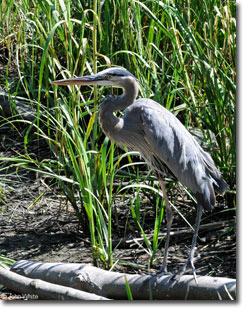
This 40 acre tract of marshy woodland is located between the Chesapeake and Ohio Canal Towpath and the Potomac River. Dierssen was donated to the State by the Dierssen family for use as a waterfowl sanctuary.
 Click here for a Map
Click here for a Map
Management
Dierssen WMA is managed by the Wildlife and Heritage Service. The mission of the Wildlife and Heritage Service is to conserve and enhance diverse wildlife populations and associated habitats while providing for public enjoyment of the State’s wildlife resources through hunting and other wildlife-dependent recreation. As a designated wildlife sanctuary, no hunting or trapping is allowed on Dierssen WMA. This property does not contain any trails, however, one boundary is formed by the C&O Canal Towpath. Two man-made impoundments provide habitat for waterfowl, wading birds, songbirds, and furbearers.
Regulations for All Users
Unless otherwise posted or with a permit issued by the Service it is UNLAWFUL to:
- Operate or possess a vehicle on roads, trails, or waterways not open to general traffic.
- Bait or feed wildlife.
- Use or construct permanent blinds or tree stands. All portable blinds or stands must be removed at the end of the day.
- Ignite, cause to be ignited, or maintain a fire.
- Camp
- Remove, disturb, damage, or destroy any mineral, plant, rock, tree, or nongame animal.
- Have dogs off leash from April 15 through August 15.
- Release any animal or plant.
- Conduct commercial activities.
- Place a cache for the purpose of geocaching.
- Operate, possess, or use combustibles, explosives, or fireworks.
- Dig for relics and treasures, remove prehistoric or historic artifacts, or use a metal detector without a permit from the Office of Archeology.
- Deposit litter or refuse including, but not limited to, animal carcasses, appliances, brush, debris, furniture, garbage, hazardous material, tires, waste paper, yard waste, or other litter.
- Vandalize real property including any blind, building, crop, equipment, gate, habitat, plant, road, sign, trail, vehicle, vessel, or other public property.
- Graze cattle, goats, horses, sheep, or other domestic animals.
- Place decoys prior to 1 hour before legal shooting hours, leave decoys overnight, or remove decoys later than 1 hour after legal shooting hours.
- Target shoot.
Hunting Regulations
Designated as a wildlife sanctuary, no hunting or trapping is allowed on Dierssen WMA.
Non-Hunting Users
Non-hunting users may access the property Sunday through Saturday year-round. Access is only by boat or via the C&O Canal Towpath. Dierssen WMA is open for the following activities:
- Hiking
- Fishing
- Biking on established trails
- Bird Watching
- Nature Photography
- Dogs must be leashed from April 15 through August 15
Directions

Located in Montgomery County along the C&O Canal upriver from Pennyfield Lock. From the Capital Beltway, take Exit 39, MD Route 190 west (River Road) toward Potomac. Turn left on Pennyfield Lock Road. On the C&O Canal Tow Path, head west for approximately 1/2 mile. For more information, contact the Gwynnbrook Wildlife Office at 410)-356-9272.
Photograph of Great Blue Heron, courtesy of John White